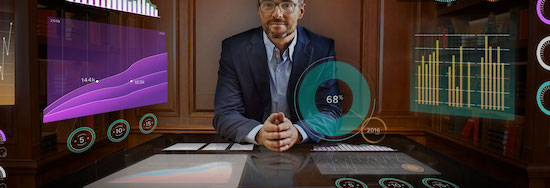Augmented Reality and the Future of Financial Services
Fortune 500 and Global 1000 financial services organizations constitute a sizable share of our portfolio. It’s a privileged position to hold: We’re granted a seat at the table with the major players in an industry whose global consequence is, well, major. And the view is fascinating.
Like any industry, finance faces challenges. Partly, these owe to the well-publicized innovations – P2P, online banking, blockchain and the rest – that have tilted the playing field and leveled those that haven’t kept up. But, even in the digital age, many of the issues we solve for are decidedly analog.
Finance is complicated business, and most customers don’t have MBAs from Warton. How do we make the (dizzyingly) complex machinations of the world economy – and what it all means to our investors – simple, memorable, and appealing?
Face time with clients is essential, but geographic and time constraints make it difficult to make time for. How do we make, and maintain, these connections from afar?
Millennial (or whatever we’re calling young people now) investors are hard to reach, and have different service expectations than their predecessors. What do they want and how can we give it to them?
While these problems don’t all stem from technology, we believe their solution might.
Reintroducing Augmented Reality
Some quick exposition: Augmented reality (AR) is a technology that lets a user overlay digital information on their (screen-mediated) actual environment, in real-time. Think PokemonGo. It’s a layer of unreality on familiar old reality.
AR has long been of interest to technologists, but Apple and Google’s respective introductions of ARkit and ARCore to their mobile operating systems have made it easily accessible on mobile devices. Consequently, this put it on the radar of marketers.
While AR and VR share similar qualities with respect to spatial computing, AR has an advantage that greatly expands its utility: it lets users keep one foot in the real world while they flirt with the virtual.
Like VR, AR creates the illusion of digital 3D objects around a user. However, an AR user remains cognizant of her surroundings and able to engage with them – that is, not entirely immersed in a digital fantasy. AR can be accessed through a head-mounted device, but also through a mobile phone screen. This makes the tech a better fit for a mobile-dominated marketplace, and the user expectations about convenience and portability it has ushered in.
Financial services has been slow to embrace AR, but the opportunity has grown too meaningful to ignore. By harnessing its power, they can make real connections with distant clients, demystify complicated investment opportunities, appeal to new money, and upgrade their digital customer service to an astonishing degree.
How? We think it could go something like this.
The Virtual Meeting
Imagine a video conference between a financial adviser and a longtime – and long-distance – high-net worth client. A few weeks before the meeting, the adviser sends his client an elegant package containing Magic Leap One, a glasses-based AR device. When the meeting notification pops up on her calendar, the client slides on the comfortable frames and begins the conference.
Initially, the scene is familiar. She and her adviser exchange pleasantries, catch up on their kids, then get down to brass tacks. The adviser begins explaining a new managed account that deals entirely in medical innovation – a hobbyhorse of the client. But as the adviser unpacks the opportunity, the familiar becomes special.
As the adviser states the growth projections associated with the account, 3D charts and graphs that represent the investment opportunity populate on the screen – triggered by the adviser to underscore and punctuate the points he’s making. Picture the way a weatherman uses digital maps to help explain the forecast and you’re in the ballpark.
One graph articulates the YOY projected growth rate for the account. Another introduces her to the individual companies within the investment, and the products they create. Another provides an overview of marketplace factors that feed the assumptions.
Each is presented in rich, vivid, and interactive form. The client taps and expands the packets that pique her interest. She homes in on the marketplace context portion, and peppers her adviser with questions about the relevant regulatory environment and competitors who are developing similar devices.
Our client might not realize that studies have shown presenting information in a 3D environment can bolster recall. What she does know is that she’s captivated by the opportunity, and the ease with which she can visualize it, isolate points of interest, and contextualize them against her broader financial goals. A flat and staid financial report has been brought to life.
The meeting goes seamlessly. It’s like her adviser is sitting across the table from her, except she’s at home in Stamford and he’s in his office in Manhattan. When it concludes, a report arrives in her inbox that summarizes their conversation and addresses the questions she’d asked.
Looking Forward to Augmented Reality
This isn’t science fiction. This interaction, in every particular, is possible today. And many of its aspects wouldn’t require additional infrastructure – like the Magic Leap One. Just a mobile phone, or a laptop, would suffice. Technology isn’t what’s holding us back. Just imagination.
Historically, large-cap financial services organizations have been slow to take the fullest advantage of the newest digital tools, tactics, and tech at our disposal. This slowness is, from a certain angle, sensible: A Fortune 1000 insurance company should favor tried and true approaches over shiny new things. But it’s also a function, on the agency side, of a failure to bring the energy and verve of, say, a Zappos presentation to a strategy document for a bank. Sometimes we, as an industry, save our finest ideas for clients we perceive to be angling for a younger or more digitally-savvy audience.
This is wrongheaded. Financial institutions succeed and fail on the basis of creditability and service. There are no quick fixes for the latter – it’s built over generations of proven returns. But service is different. It’s an area where you can win right now. And it’s, pardon the hyperbole, the single area where the most cutting-edge digital tools in our toolkit can make the most significant difference. And AR is poised to do just that.




